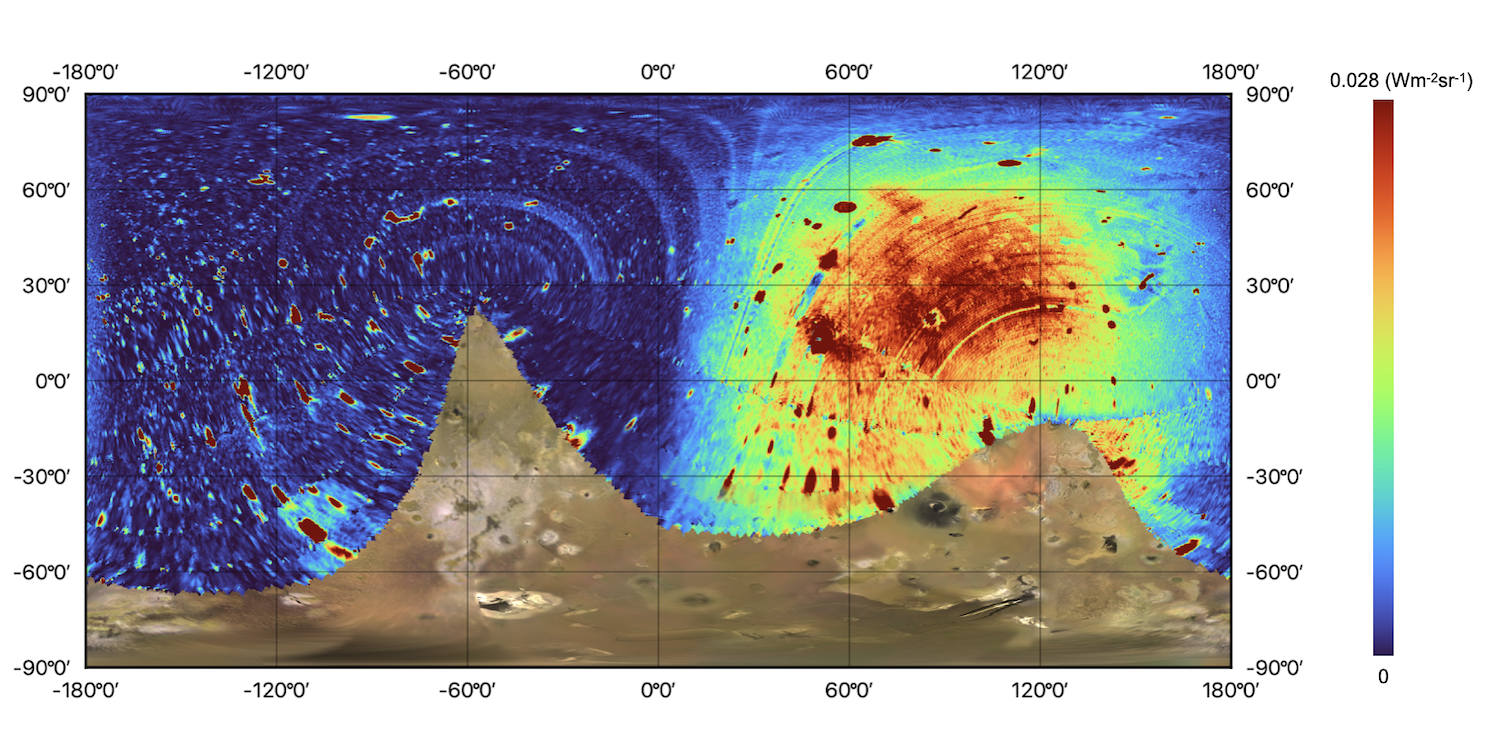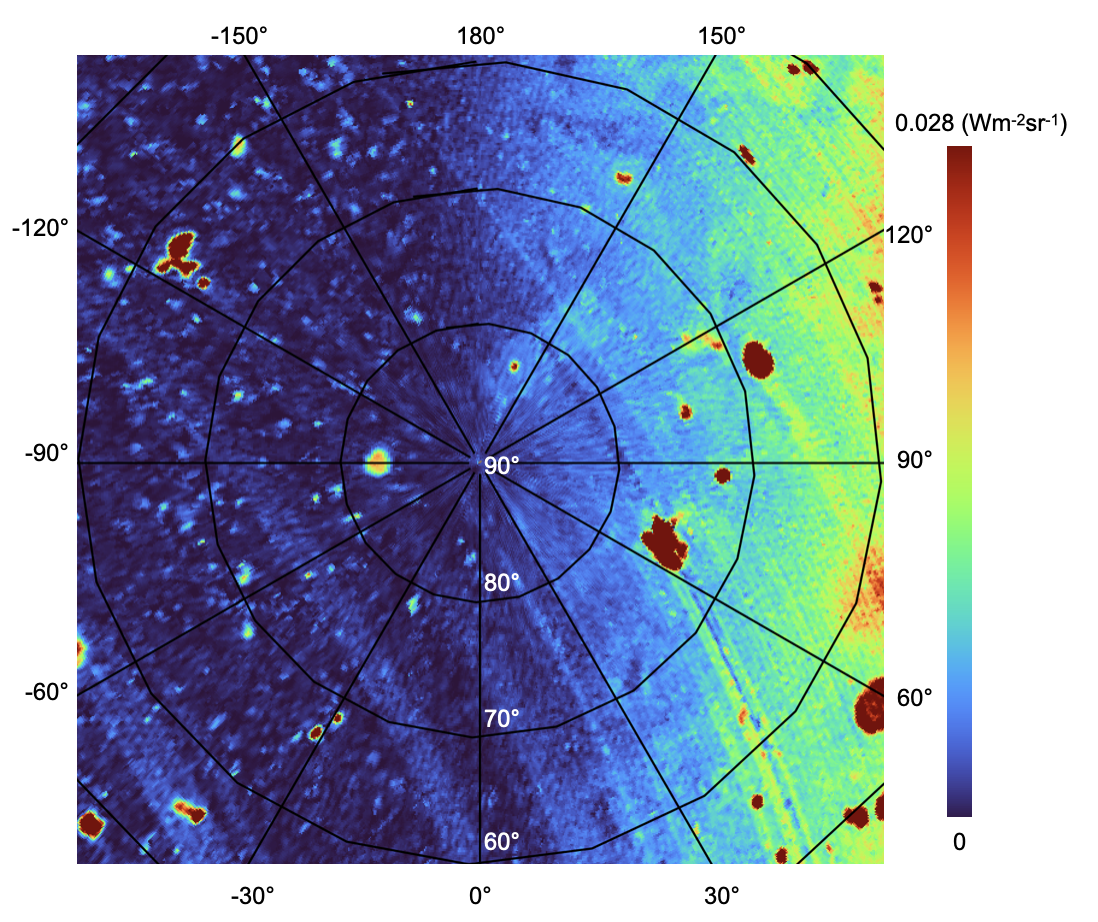Io JIRAM observations from Juno orbits 41-53
- 1INAF - IAPS, Roma, Italy (francesca.zambon@inaf.it)
- 2Jet Propulsion Laboratory, California Institute of Technology, Pasadena, CA, USA
- 3Planetary Science Institute, Tucson, AZ, USA
- 4Cornell University, Ithaca, NY, USA
- 5Agenzia Spaziale Italiana, Rome, Italy
- 6Southwest Research Institute, San Antonio, TX, USA
Io, the most volcanically active body of the Solar System, has been the target of numerous ground-based and remote sensing observations over the past decades, improving our knowledge about the satellite.
Recent studies, based on data acquired by the Jovian InfraRed Auroral Mapper (JIRAM) [1] on board the Juno mission, confirm the presence of hundreds of hot spots [2,3,4]. New observations of Io obtained by JIRAM from Juno perijove 41 up to 53 provided very good spatial coverage of the northern hemisphere and a partial coverage of the southern hemisphere with a spatial resolution ranging between 27 and 9 km/pixel (Fig. 1). Furthermore, the very last observations reaching a spatial resolution of a few km/pixel, revealed unseen details of about ninety paretae, confirming the presence of several lava lakes [5] and allowing for a detailed study of their morphology [6].
In this work, we consider the JIRAM M-filter images centered at 4.8 µm, to integrate and improve the results obtained by [3]. We selected images from orbits 41-53, characterized by an unprecedented spatial resolution and negligible radiance saturation of the detector. For each orbit, we identify the hot spots giving priority to images with higher spatial resolution in case of data redundancy, to monitor the overall total spectral radiance distribution across the satellite and the temporal variability of each hot spot, if covered by multiple Juno orbits [7]. Thanks to these new dataset, we are able to better identify hot spots unresolved in [3], and locate new small and faint hot spots. Moreover, the good high spatial resolution coverage of the northern hemisphere (Fig. 2) allows to distinctly discern hot spots in this region, as well as in the rest of the satellite. JIRAM data represent a unique chance to study Io’s surface. In the next future, the spatial coverage will be increased by JIRAM observations following orbits 53, including also the southern polar region. This will be fundamental for a comprehensive understanding of this intriguing satellite.
Acknowledgments
This work is supported by the Agenzia Spaziale Italiana (ASI). JIRAM is funded by the ASI–INAF Addendum n. 2016-23-H.3-2023 to grant 2016-23-H.0. Part of this work was performed at the Jet Propulsion Laboratory, California Institute of Technology, under contract with NASA.
References
[1] Adriani, A., et al. (2017). JIRAM, the Jovian infrared auroral mapper. SSR, 213(1–4), 393– 446. [2] Mura, A., et al. (2020). Infrared observations of Io from Juno. Icarus 341, 113607. [3] Zambon, F., et al. (2023). Io Hot Spot Distribution Detected by Juno/JIRAM. GRL, 50, e2022GL100597. [4] Davies, A. et al. (2024). Io's polar volcanic thermal emission indicative of magma ocean and shallow tidal heating models. Nat. Ast., Vol. 8, p. 94-100. [5] Mura A. et al. (2024). Hot rings on Io observed by Juno/JIRAM. Nature Communications Earth & Environment, in press. [6] Mirino, M. et al. (2024). Morphological characterization of Io’s Paterae and their geological context. EPSC. [7] Mura, A. et al. (2024). The temporal variability of Io's hotspots. Frontiers in Astronomy and Space Sciences, in press.

Figure 1: Io global radiance map from Juno PJ51.

Figure 2: Io northern polar region radiance map from PJ51 at 9 km/pixel (JIRAM image JM0510_2023-05-16T03-13-11).
How to cite: Zambon, F., Mura, A., Lopes-Gautier, R. M., Tosi, F., Rathbun, J., Pettine, M., Mirino, M., Nodjoumi, G., Castagnoli, C., Cicchetti, A., Moirano, A., Noschese, R., Sordini, R., Plainaki, C., Sindoni, G., Hansen-Koharcheck, C., Becker, H., and Bolton, S.: Io JIRAM observations from Juno orbits 41-53, Europlanet Science Congress 2024, Berlin, Germany, 8–13 Sep 2024, EPSC2024-502, https://doi.org/10.5194/epsc2024-502, 2024.